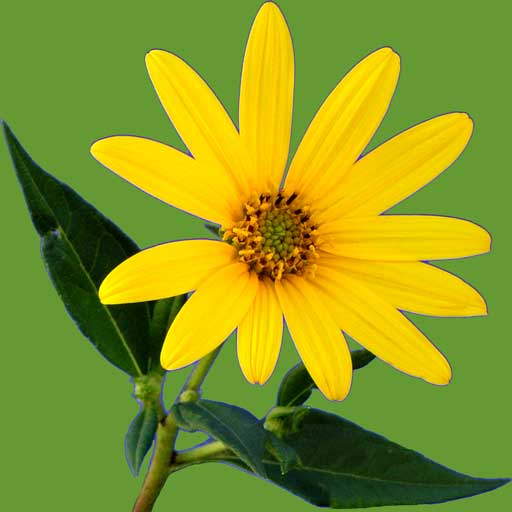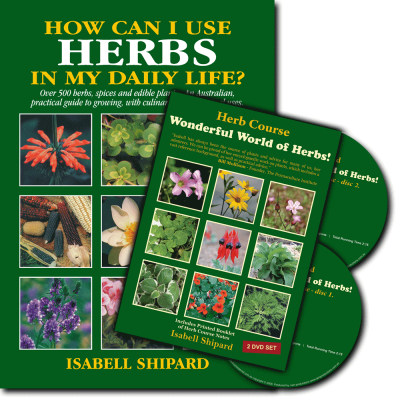Spilanthes acmella syn. S. oleracea F. Asteracea
Description
Tender annual to 40cm, with soft branching stems; ovate leaves 6cm long, with soft, wavy margins; singular, brightyellow flowers 1cm diameter, form as tight cones, on short terminal stems. Although the plant is a member of the daisy family, it does not have the typical daisy-like petals that we recognise chamomile, calendula or sunflower by.
… … omitted text, please see How can I use HERBS in my daily life? for full text.

Medicinal Uses
Spilanthol, a chemical with effective local anaesthetic action has been identified in the plant. This action works surprisingly fast. If you have a toothache and rub a leaf on the gum area of the toothache, the area tingles and then goes numb within a few seconds. Or the leaf, after chewing to release the juice, is tucked in the mouth between the gums and cheek for toothache. It is also used for sore gums, teething babies, and mouth ulcers. The numbness lasts for a short period of time, and acts to desensitise the area and diminish the pain. Rub on as often as needed to relieve pain or discomfort. Over the last few years I have had many people in pain come to the farm, to experience this quick relief method for toothache. This does not mean, a person can put off going to the dentist, but it does give temporary relief until you get enough courage to see a dentist. A lady from New South Wales rang with severe mouth ulcers, asking if there is a herb that could help. I suggested this plant and posted her some. She wrote to tell me “it’s great, effective and swift”. As the leaf has antiseptic action too, it helps to clear bacteria and infections. The leaves can be rubbed on cuts, hard to heal sores and acne. Also, this plant has a natural antibiotic action, which adds to the healing effect. Try the leaves on cold sores and school sores.
For people who suffer with thrush, candida, frequent viruses, fungal and auto-immune diseases, eating the leaves in salads or sandwiches, can be of real benefit. The flavour is tangy. Mixed in with other greens and vegetables it is hardly detectable. Many health practitioners recognise Candida albicans as wide spread and harbouring in many people, particularly in hot climates. It may grow in the body where sugar is consumed, and bread made from fast rise yeast, some processed and chemical ‘enhanced’ foods, birth control pills and pharmaceutical drugs. Some researchers are now saying it is not a question of whether we have candida, but how much it has invaded our bodies and how seriously it has afflicted us. Some people have no obvious symptoms, others suffer what seems to be the entire range of human problems, either directly from candida and its by-products wastes and toxins; or from other diseases, which can gain, a foothold after candida has weakened the immune system.
Known symptoms of candida are: tiredness, chronic fatigue, aches all over the body, headaches, bouts of diarrhea or constipation; gastrointestinal discomfort; disturbance in smell, taste, vision, hearing, concentration and memory; kidney infections; sensitivity to chemicals; smells and foods; loss of libido, impotence, sinus, hayfever, insomnia, depression, respiratory conditions, lupus, fungal infections between fingers, toes, in mouth, under breasts, in groin, vagina, scrotum and penis. The candida culprit proliferates super fast in warm to tropical climates, because like yeast, it multiplies quickly. Wet, hot humid weather, and the associated problems of living in an atmosphere of mould on buildings, etc., in tropical climates, fuel candida further in the body. We can assist the body in lowering the candida effects by watching foods and other substances we ingest, and assisting the body with natural antibiotics, like the toothache plant. Regularly using plants that are rich in chlorophyll or natural antibiotics would be beneficial, like aloe vera, nasturtiums, comfrey, ginger, garlic, tea tree, rejuvelac from wheat grass, and plants rich in germanium like herb robert and watercress. Add a few leaves to salads, sandwiches, steamed vegies, and stirfries; as it might just put the candida fungus to sleep, so you can take control of your life, and be free of some unpleasant symptoms. It is of interest too, that the spilanthol in the toothache plant activates the salivary glands, and assists digestion. Sometimes when asked to speak on herbs and their uses to various community groups, I ask if someone in the audience would like to chew a toothache plant leaf and tell what they feel. When the leaf is held on the tongue or chewed it numbs that area of the tongue. When the volunteers taste the herb they are amazed at the effect. I tell them it is a good herb to give to someone who talks too much as it can send their tongue to sleep, and this brings lots of laughter from the audience. Jokes aside, the toothache plant rubbed on the right spot, can bring rapid relief.
… … omitted text, please see How can I use HERBS in my daily life? for full text.


